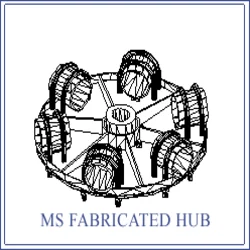MECHANICAL TESTING (Deflection)
The fan deflection testing is carried out to ensure the quality as follows:
-
To load the FRP fan blade till failure, in the proportion 20% of load at a cross section close to neck of the blade, 30% of load at cross-section approximately at the middle and 50% of load at a cross-section close to the free end.
-
To record the load and deflection at the three loading locations.
-
To observe any abnormal behavior during the load test and observe the failure pattern.
The fan deflection test is carried out for the predetermined load as follows:
-
The FRP fan blade is fixed on a rigid platform with the help of holding clamps.
-
Three loading positions are marked for the load runners. The outer most position is at a distance of d1 from the tip (free end) and takes 50% of superposed load. The innermost position is at a distance of d2 mm from tip and takes 20 % of superposed load schematic view of loading positions. The deflection measuring points are same made using iron runners and matching the aerofoil profile at the respective loading points. Pre-calibrated dead weights are used for the test. Three suitable weighing pans are fabricated in-house and weighed. It was found that the total weight of the three pans came out to be about W1 Kg. Hence, the weighing pans were not used initially; instead hangers were used till the total load of about W Kg.
-
Initial deflection readings with only self-weight of the blade and the holding clamp with load runners were noted down. The deflections were measured with the help of pointers pointing on to a wooden meter scale clamped to a fix support. The hangers were hooked to the three loading clamps respectively. The loading was done in steps of w Kg. Therefore, the load at loading position W1 was increased in steps w1Kg. The load at loading position W2 was increased in steps of w2. and the load at the loading positions W1, W2 and W3 were after each loading steps were noted. This loading system was continued up-to W Kg. Then the load hangers were removed and weighing pans were hung at three loading locations. Subsequently, dead weights were added to the weighing pans in step and readings for loads and deflections were recorded till failure.
OBSERVATIONS:
Following observations are made on the basis of readings achieved:
-
Initial zero readings was taken with self-weight of the blade and a superposed load of holding clamps with wooden load runners.
-
The creep effect was studied at the superposed load in Kg. kept for about 30 minute. After 30 minutes, it was observed that the loading position W1 became a creep in mm, the loading position W2 also became a creep effected.
-
Cross checking up-to failure de-lamination of the chord joint (edge of the blade near the innermost loading positions) was observed along the longitudinal axis of the blade over a length of about X mm. The total failure load was observed in Kg.
-
Maximum deflection observed by the outermost loading point in mm at the failure load.
-
Load-deflection curve expectedly shows a typical curve of a FRP specimen under a flexural load.
-
6.The blade was cut at the three loading locations to observe the thickness of cross-section of chord of the blade across the cut sections with identification numbers.
CONCLUSIONS:
The ultimate superposed load on the given sample of FRP blade was determined in Kg. No abnormal behavior was stopped for a period of 30 minutes. This however, is natural for FRP material. The maximum deflection at the outermost loading location was found in mm. After failure when the superposed loads were removed, the blade almost regained its original position, showing that even at failure the FRP material remained elastic. This is because, the failure was entirely due to de-lamination of FRP layers in the vicity of the loading point W1.
Shear stress and Bending moment in Fan
(E.g. Diagram of 6’F Fan at 20 mm wg of total Pressure)
Hub design
The material used for manufacturing the hub is mild steel/ Stainless steel. The following are the properties of mild steel

-
Tensile stress = N/mm2
-
Shear stress = N/mm2
The area of hub under the shear stress=? x d x t = mm2
Therefore the cross breaking shear strength of the hub N = Area under shear stress x shear stress
Total shear load acting on the hub (N) = No. of blades x centrifugal force on each blade+ Thrust load acting on all the blades
The shear strength of the hub must be greater than the total shear load acting on the hub.
Design of U bolts
The area of u bolts under the shear load = 4 xΠ/4 x d2 = mm2
Therefore the cross breaking shear strength of the u bolt = A x Fs The total shear load acting on each pair of u bolt (N) = centrifugal force acting on each blade + thrust on each blade.
The shear force acting on the I - bolts (N) = centrifugal force due to the hub and blades + thrust force acting on the bolts.
The shear strength of the u bolts must be higher than the shear load acting on the U-bolts.